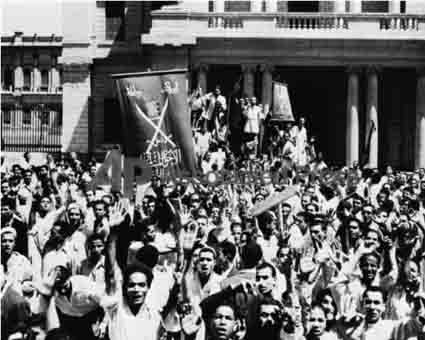
Political Islam is the politicisation of the Islamic faith for political purposes. In common with other faiths, Islam is a religion that aims to organise the relationship between the believer and his Creator and His teachings, for the benefits which these bestow, according to what is contained in that religion’s holy scripture.
THE AIM OF POLITICAL ISLAM, on the other hand, is to exploit religion and the sentiments of believers for political purposes, purposes which have no relation to religiosity but rather to political control over the state, over the capacities of the nation and its population in order to serve the interests of a specific group in power.
In this short essay, I would like to spotlight some of the reasons which have led in the 20th century to the emergence of political Islam, and which in turn have led to the manifestation of extremism and terrorism against all those, Muslim and non-Muslim, who refuse to follow their course, as represented in particular by a strong enmity to western culture and its humane values. Any study of such a theme would of course be long and difficult one, but I shall attempt to deal with it here as succinctly as possible.
Sunni political Islam began in Egypt with the formation in 1928 of the Muslim Brotherhood party under Shaykh Hasan al-Bannā’, with the support and direction of Saudi Arabia. There is consequently a relationship between this organisation and the Wahhabist doctrine founded in the 18th century in the Arabian Peninsula by Shaykh Muhammad ibn ‘Abd al-Wahhāb. The teachings of this doctrine reflect the nature of the harsh Arabian desert, its desiccation and scarcity of resources, and the roughness of the mores of its Bedouin inhabitants. Accordingly, Wahhabism licenses raiding, plunder and pillaging against non-Muslims, and even against non-Wahhabi Muslims whom they considered to be infidel, Shi‘ites in particular.
The birth of the Wahhabist movement coincided with the foundation of the first Saudi state under Shaykh Muhammad ibn Sa‘ūd, in the same region. An alliance was formed between the two families, the Āl Sa‘ūd and the family of Shaykh Muhammad ibn ‘Abd al-Wahhāb – the former directing affairs of state, the latter responsible for the religious and educational direction, ensuring the loyalty of the people to the political authority and enlisting them in its defence. This relationship has continued to this day.
The leadership of the Muslim Brotherhood did not reveal their political aims at the outset but pursued a course of gradualism and sleight-of-hand, as circumstances dictated. In the beginning the organisation appeared as a charitable group for the education of the youth and the provision of religious guidance and aid for the poor. Gradually, however, the leadership of the organisation revealed its true nature and engaged in acts of violence such as the assassination of members of the Egyptian government, one of whom was the Prime Minister Ahmad Mahir in 1945. Similarly, the party later made a failed attempt in 1965 to assassinate the Egyptian president Gamal ‘Abd al-Nāsir, successfully assassinated President Anwar Sadat in 1981, and subsequently failed to assassinate former President Husni Mubarak in Addis Ababa in 1995.
The task ahead for Muslim intellectuals is to take on the serious work of putting a halt to this self-annihilation
After the rise of oil wealth in Saudi Arabia and the opening up of Islamic banks – notably by Saudi princes[1] – in various parts of the world and especially in Arab Islamic states, large amounts of money were earmarked for the opening of schools and religious foundations in their tens of thousands throughout various parts of the globe, and in Egypt, Pakistan and Afghanistan in particular. From these issued the Taliban and the followers of al-Qaeda, whose aims were the propagation of religious extremism according to the Wahhabi teachings, and the establishment of Islamic parties gestated by Egypt’s Muslim Brotherhood, bearing various names such as the Salvation Front in Algeria, Hamas in Palestine, Al-Nahda in Tunisia and so on. An American study confirms that over the last two decades Saudi Arabia has poured 87 billion dollars into propagating Wahhabi religious extremism.[2]
Of course there are other factors that aided the rising tide of political Islam and religious extremism, such as economic crises and the spread of poverty, the population explosion in the Muslim world, the failure of its semi-secular governments to solve the problems of their peoples, the Islamic revolution in Iran, and the communist uprising in Afghanistan which drew down the Soviet invasion. Then there are the petro-dollars from the Arabian oil states of the Gulf which served to establish, support and arm the Mujahid organisations fighting the Soviet occupation, one of which was the organisation of al-Qaeda.
But one may well ask why religious extremism has, over the last 50 years, manifested itself in the Islamic world in an age of ‘resurgence’ and renewal which the Islamic peoples in the 20th century were going through? The answer to this is that the Islamic world today is passing through the same phase which the Christian world in Europe passed through in an era of Renaissance and religious reform in the 15th and 16th centuries. During this period one can observe the same rise in religious fanaticism and religious war. When Martin Luther in Germany and Calvin in Switzerland embarked on religious reforms it was in this 16th century, and not during the obscurer Middle Ages. The same thing is happening now in the Islamic world. The explanation for this is that conflicts break out during a time of heightened historical sensitivities when there are social, cultural and political changes taking place, since people do not accept change in equal measure. In such a state society comes to be divided into two camps: one for, and one against, change. Thus between the two camps violent, bloody conflicts ensue.

Suggested Reading
At an increasingly accelerating pace Muslims are becoming less and less isolated from what is taking place in a changing world. This is due to information technology and the media revolution, to sophisticated means of transportation and to the phenomenon of different peoples rubbing shoulders with each other through immigration and increasingly effortless tourism. They are thus being influenced by developments taking place in the West, yet at differing rates of speed. For there are large sectors of Muslim populations who have accepted changes, and embraced western culture and its lifestyle, but at the same time there is a minority of Muslims who refuse these changes. It is for this reason that conflicts have broken out over the last 50-year period.
Coming back to the European example, the peoples of Europe have gone through long, destructive religious and non-religious wars, the worst of these being the two World Wars of 1914-1918 and 1939-1945. But now these European states have reached the pinnacle of integrity and rationality, while the Islamic states remain backward. Nevertheless, what gives us hope is that those who refuse change and peaceful co-existence with the rest of the world remain a minority, and this is the reason for their having to resort to terrorism – to gain their aims through violent means. They will perforce soon become extinct since history is against them.
The one anomaly is this is the Muslim who flees his country because of its backward culture and oppressive political system, but on settling in the West still wishes to impose this culture on their host countries, forgetting that what they are doing is re-creating in the West the same oppressive environment which forced them to flee in the first place.
For this reason a weighty task lies ahead for Muslim, secular, liberal, and enlightened intellectuals – to take on the serious work of putting a halt to this self-annihilation carried out by fanatical minorities among the Muslim immigrants in the West.
[1] Kāmil al-Najjār, لعنة آل سعود , Hewar, June 17th 2011.
[2] Curtin Winsor, ‘Saudi Arabia, Wahhabism and the Spread of Sunni Theofascism’, Mideast Monitor, June/July 2007.


